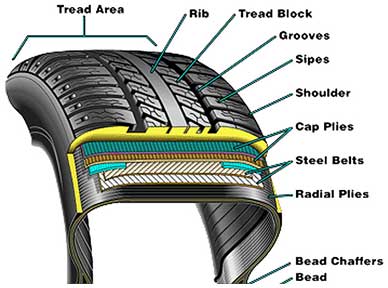Your Tire Maintenance
QUALITY WORK - COMPETITIVE PRICES
Complete tire service for your car or truck. Properly inflated tires will get better gas mileage.
|
Pressure - Underinflation results in unnecessary tire
stress, irregular wear, loss of control and accidents. A tire can lose up to
half of its air pressure and not appear to be flat! |
|
|
Alignment - A bad jolt from hitting a curb or pothole
can throw your front end out of alignment and damage your tires. Have a tire
dealer check the alignment periodically to ensure that your car is properly
aligned. |
|
|
Rotation - Regularly rotating your vehicle's tires
will help you achieve more uniform wear. Unless your vehicle's owners manual
has a specific recommendation, the guideline for tire rotation is approximately
every 6,000 miles. |
|
|
Tread - Advanced and unusual wear can reduce the
ability of tread to grip the road in adverse conditions. Visually check your
tires for uneven wear, looking for high and low areas or unusually smooth
areas. Also check for signs of damage. |

|
Refer to your vehicle's owners manual for the proper level of inflation; it may also be posted on the door post or in the glove box. |
|
|
When you check the air pressure, make sure the tires are cool - meaning they are not hot from driving even a mile. (Note: If you have to drive a distance to get air, check and record the tire pressure first and add the appropriate air pressure when you get to the pump. It is normal for tires to heat up and the air pressure inside to go up as you drive. Never "bleed" or reduce air pressure when tires are hot.) |
|
|
Remove the cap from the tire valve, firmly press a tire gauge onto the valve and note the reading. |
|
|
Add air to achieve recommended air pressure. |
|
|
If you overfill the tire, you can release air by pushing on the metal stem in the center of the valve with a fingernail or the tip of a pen. Then recheck the pressure with your tire gauge. |
|
|
Replace the valve cap. |
|
|
Repeat with each tire, including the spare (Note: Some spare tires require higher inflation pressure). |
|
If your car's suspension system is out of alignment, your tires will wear unevenly and you may experience handling problems. Potholes and rough roads can contribute to problems with alignment. |
|
|
Front-wheel drive vehicles, and those with independent rear suspension, require alignment of all four wheels. |
|
|
Have a tire dealer check your alignment periodically as specified by your vehicle's owners manual or if handling problems develop, such as "pulling" or vibration. |
|
|
Also have your tire balance checked periodically. An unbalanced tire and wheel assembly may result in irregular wear. |
|
Each tire on your car supports a different amount of weight; this unequal weight distribution causes your tires to wear at different rates. By rotating your tires, you can extend their useful life. |
|
|
If your tires show uneven wear, ask your tire dealer to check for and correct any misalignment, imbalance or other mechanical problem involved before rotation. |
|
|
Refer to your vehicle's owners manual for rotation recommendations. If no rotation period is specified, tires should be rotated approximately every 6,000 miles. |
|
|
Sometimes front and rear tires use different pressures. After rotation, adjust individual tire air pressure to the figures recommended for each wheel position by the vehicle manufacturer. |
|
When the tread is worn down to 1/16 of an inch, tires must
be replaced. |
|
|
All tires have "wear bars," which are small, raised bars of rubber in the groove that indicate when tires are worn out. If your tread is worn down to the wear bars, it's time for a new tire. |
|
|
A penny is a reliable tool to check tire tread. |
|
|
Visually check your tires for signs of uneven wear. You may have irregular tread wear if there are high and low areas or unusually smooth areas. Also make sure no nails or other objects are embedded in the tire. Consult your tire dealer as soon as possible if you see problems. |
What are your tires age? It is recommended to replace tires older than 7 years. Go here to tell how old your tires are.
Hold on to your sales receipts. Most tire manufacturer's warranties cover their tires for four years from the date of purchase, or five years from the week the tires were manufactured.
Practice good driving habits, which will help keep your tires in good condition.
If properly cared for, tires can last a long time - usually from 40,000 to 80,000 miles, depending on the application.
SMOG is automatically loaded onto DMV but takes a couple hours to process. I was able to go to breakfast and register my car with their new
kiosk in less than 15 minutes.
Leslie T.